Sustainability Communication in Rural Tourism: Website Content Analysis, in Viseu Dão Lafões Region (Portugal)
Abstract
1. Introduction
2. Literature Review
2.1. The Emphasis on Rural Tourism
- located in rural areas;
- rural in scale—both in terms of buildings and settlements—and, therefore, usually small scale;
- functionally rural, that is, built upon the rural world’s special features of small-scale lodging, open space, contact with nature and the natural world, heritage, “traditional” societies, and “traditional” practices;
- traditional in character, growing sustainably and organically, connected with local communities and controlled by them for the long-term good of the area;
- of many different kinds, representing the complex pattern of the rural environment, economy, history, and location.
2.2. The Sustainability of Rural Tourism
- sustain the rural culture and character of local communities;
- sustain the rural economy;
- sustain the local tourism industry which should be viable in the long term—and in turn mean the promotion of successful and satisfying holiday experiences;
- develop sufficient understanding, leadership and vision amongst the decision makers in the rural space in order to work towards a balanced and diversified rural economy.
2.3. Communication in Rural Tourism—A Path towards Sustainability
3. Methodology and Case Study
3.1. Study Region
- -
- Cultural Tourism: it is possible to visit various monuments, churches, and museums without forgetting the immaterial component of traditions, as well as some historical personalities such as Viriato (a Lusitanian warrior who fought bravely with the Romans) and Grão Vasco (one of the most acclaimed painters of the 15th century in Portugal).
- -
- Health and Wellness Tourism: in this region, it is possible to find most of the spas in operation in Portugal, with waters very rich in minerals and indicated for the prevention and treatment of various diseases.
- -
- Gastronomy and Wines: Dão wine is produced in this region, as well as some very characteristic dishes of national gastronomy, such as veal à Lafões, roasted lamb, carqueja (a wild plant) rice, and rancho à moda de Viseu (a dish made with various meats, chickpeas, and pasta), without forgetting the traditional pastry.
- -
- Nature Tourism: the region allows the performance of various adventure sports, whether in the mountains or on the rivers. For bicycle lovers, the region has the Dão cycle track, which is the largest in Portugal and one of the most beautiful.
3.2. Data Gathering Procedures
4. Results and Discussion
4.1. Information and Process
4.2. Value Added
4.3. Relationships
4.4. Design and Usability
4.5. Trust
4.6. Sustainability Communication
5. Conclusions
Author Contributions
Funding
Institutional Review Board Statement
Informed Consent Statement
Data Availability Statement
Acknowledgments
Conflicts of Interest
References
- Cunha, C.; Kastenholz, E.; Carneiro, M.J. Entrepreneurs in rural tourism: Do lifestyle motivations contribute to management practices that enhance sustainable entrepreneurial ecosystems? J. Hosp. Tour. Manag. 2020, 44, 215–226. [Google Scholar] [CrossRef]
- Fortunato, M.W.-P. Supporting rural entrepreneurship: A review of conceptual developments from research to practice. Community Dev. 2014, 45, 387–408. [Google Scholar] [CrossRef]
- Pato, L.; Kastenholz, E. Marketing of rural tourism—A study based on rural tourism lodgings in Portugal. J. Place Manag. Dev. 2017, 10, 121–139. [Google Scholar] [CrossRef]
- Lordkipanidze, M.; Brezet, H.; Backman, M. The entrepreneurship factor in sustainable tourism development. J. Clean. Prod. 2005, 13, 787–798. [Google Scholar] [CrossRef]
- Pato, M.L.; Teixeira, A.A. Twenty Years of Rural Entrepreneurship: A Bibliometric Survey. Sociol. Rural. 2016, 56, 3–28. [Google Scholar] [CrossRef]
- Irshad, H. Rural Tourism—An Overview; Governmnt of Alberta Agriculture and Rural Development: Alberta, Canada, 2010. Available online: https://www1.agric.gov.ab.ca/$Department/deptdocs.nsf/all/csi13476/$FILE/Rural-Tourism.pdf (accessed on 25 May 2021).
- Kallmuenzer, A.; Nikolakis, W.; Peters, M.; Zanon, J. Trade-offs between dimensions of sustainability: Exploratory evidence from family firms in rural tourism regions. J. Sustain. Tour. 2018, 26, 1204–1221. [Google Scholar] [CrossRef]
- Antão-Geraldes, A.M.; Sheppard, V.A. Promoting sustainable tourism in rural and natural areas through small business innovation: The case of Atenor village (Northeast, Portugal). J. Ecotourism 2020, 19, 185–193. [Google Scholar] [CrossRef]
- Komppula, R. The role of individual entrepreneurs in the development of competitiveness for a rural tourism destination—A case study. Tour. Manag. 2014, 40, 361–371. [Google Scholar] [CrossRef]
- Zhang, L.; Zhang, J. Perception of small tourism enterprises in Lao PDR regarding social sustainability under the influence of social network. Tour. Manag. 2018, 69, 109–120. [Google Scholar] [CrossRef]
- Nomm, A.H.; Albrecht, J.N.; Lovelock, B. Advocacy and community leadership as functions in national and regional level destination management. Tour. Manag. Perspect. 2020, 35, 100682. [Google Scholar] [CrossRef]
- Kastenholz, E. “Management of demand” as a tool in sustainable tourist destination. J. Sustain. Tour. 2004, 12, 388–408. [Google Scholar] [CrossRef]
- Pato, L. The importance of eco-labels certifications and ICT in the promotion of sustainable tourism—Case study of a rural tourism unit. Millenium 2020, 2, 369–377. [Google Scholar]
- Peña, A.I.P.; Jamilena, D.M.F.; Ángel, M.; Molina, R. Impact of Customer Orientation and ICT Use on the Perceived Performance of Rural Tourism Enterprises. J. Travel Tour. Mark. 2013, 30, 272–289. [Google Scholar] [CrossRef]
- Keller, K.L. Building strong brands in a modern marketing communications environment. J. Mark. Commun. 2009, 15, 139–155. [Google Scholar] [CrossRef]
- Daugstad, K. Negotiating landscape in rural tourism. Ann. Tour. Res. 2008, 35, 402–426. [Google Scholar] [CrossRef]
- Bramwell, B. Rural tourism and sustainable rural tourism. J. Sustain. Tour. 1994, 2, 1–6. [Google Scholar] [CrossRef]
- Bramwell, B.; Lane, B. Sustainable Tourism: An Evolving Global Approach. J. Sustain. Tour. 1993, 1, 1–5. [Google Scholar] [CrossRef]
- Lane, B. Sustainable rural tourism strategies: A tool for development and conservation. J. Sustain. Tour. 1994, 2, 102–111. [Google Scholar] [CrossRef]
- Lane, B.; Kastenholz, E. Rural tourism: The evolution of practice and research approaches—Towards a new generation concept? J. Sustain. Tour. 2015, 23, 1133–1156. [Google Scholar] [CrossRef]
- Lane, B. What is rural tourism? J. Sustain. Tour. 1994, 2, 7–21. [Google Scholar] [CrossRef]
- Kastenholz, E.; Eusébio, C.; Carneiro, M.J. Segmenting the rural tourist market by sustainable travel behaviour: Insights from village visitors in Portugal. J. Destin. Mark. Manag. 2018, 10, 132–142. [Google Scholar] [CrossRef]
- Eusébio, C.; Carneiro, M.J.; Kastenholz, E.; Figueiredo, E.; da Silva, D.S. Who is consuming the countryside? An activity-based segmentation analysis of the domestic rural tourism market in Portugal. J. Hosp. Tour. Manag. 2017, 31, 197–210. [Google Scholar] [CrossRef]
- Jepson, D.; Sharpley, R. More than sense of place? Exploring the emotional dimension of rural tourism experiences. J. Sustain. Tour. 2013, 23, 1157–1178. [Google Scholar] [CrossRef]
- Pesonen, J.; Komppula, R. Rural Wellbeing Tourism: Motivations and Expectations. J. Hosp. Tour. Manag. 2010, 17, 150–157. [Google Scholar] [CrossRef]
- Christou, P.; Sharpley, R. Philoxenia offered to tourists? A rural tourism perspective. Tour. Manag. 2019, 72, 39–51. [Google Scholar] [CrossRef]
- Smarandache, M.C. The Impact of e.u. Structural Funds to the Development of the Rural Tourism Infrastructure of Gorj County, Romania. Ann. Constantin Brancusi’ Univ. Targu-Jiu. Econ. Ser. 2020, 68–73. [Google Scholar]
- Ribeiro, M.; Marques, C. Rural tourism and the development of less favoured areas?between rhetoric and practice. Int. J. Tour. Res. 2002, 4, 211–220. [Google Scholar] [CrossRef]
- Kastenholz, E.; Carneiro, M.J.; Marques, C. Marketing the rural tourism experience. In Strategic Marketing in Tourism Services; Tsiotsou, R.H., Goldsmith, R.E., Eds.; Emerald Group Publishing Limited: Bingley, UK, 2012; pp. 247–263. [Google Scholar]
- Kim, S.; Jamal, T. The co-evolution of rural tourism and sustainable rural development in Hongdong, Korea: Complexity, conflict and local response. J. Sustain. Tour. 2013, 23, 1363–1385. [Google Scholar] [CrossRef]
- UN. Report of the World Commission on Environment and Development: Our Common Future; United Nations; Oxford University Press: Oxford, UK, 1987. [Google Scholar]
- Choi, S.; Lehto, X.Y.; Morrison, A.M. Destination image representation on the web: Content analysis of Macau travel related websites. Tour. Manag. 2007, 28, 118–129. [Google Scholar] [CrossRef]
- Eusébio, C.; Kastenholz, E.; Breda, Z. Tourism and sustainable development of rural destinations: A stakeholders’ view. Rev. Port. Estud. Reg. 2014, 36, 13–21. [Google Scholar]
- McAreavey, R.; McDonagh, J. Sustainable Rural Tourism: Lessons for Rural Development. Sociol. Rural. 2010, 51, 175–194. [Google Scholar] [CrossRef]
- Tölkes, C. Sustainability communication in tourism—A literature review. Tour. Manag. Perspect. 2018, 27, 10–21. [Google Scholar] [CrossRef]
- Martínez, J.M.G.; Martín, J.M.M.; Fernández, J.A.S.; Mogorrón-Guerrero, H. An analysis of the stability of rural tourism as a desired condition for sustainable tourism. J. Bus. Res. 2019, 100, 165–174. [Google Scholar] [CrossRef]
- Crosby, A. Re-inventando el turismo rural. In Re-Inventando el Turismo Rural; Crosby, A., Ed.; Laertes: Barcelona, Spain, 2009. [Google Scholar]
- Puczkó, L.; Rátz, T. Tourist and Resident Perceptions of the Physical Impacts of Tourism at Lake Balaton, Hungary: Issues for Sustainable Tourism Management. J. Sustain. Tour. 2000, 8, 458–478. [Google Scholar] [CrossRef]
- Roberts, L.; Hall, D. Rural Tourism and Recreation Principles to Practise; Cab International: Oxon, UK, 2003. [Google Scholar]
- Buhalis, D.; Law, R. Progress in information technology and tourism management: 20 years on and 10 years after the Internet—The state of eTourism research. Tour. Manag. 2008, 29, 609–623. [Google Scholar] [CrossRef]
- Law, C.H.R.; Qi, S.; Buhalis, D. Progress in tourism management: A review of website evaluation in tourism research. Tour. Manag. 2010, 31, 297–313. [Google Scholar] [CrossRef]
- Tiago, F.; Gil, A.; Stemberger, S.; Borges-Tiago, T. Digital sustainability communication in tourism. J. Innov. Knowl. 2021, 6, 27–34. [Google Scholar] [CrossRef]
- Bridges, C.M.; Wilhelm, W. Going Beyond Green: The@ Why and Ho—of Integrating Sustainability Into the Marketing Curriculum. J. Mark. Educ. 2008, 30, 33–46. [Google Scholar] [CrossRef]
- Olya, H.; Altinay, L.; Farmaki, A.; Kenebayeva, A.; Gursoy, D. Hotels’ sustainability practices and guests’ familiarity, attitudes and behaviours. J. Sustain. Tour. 2021, 29, 1063–1081. [Google Scholar] [CrossRef]
- Hashim, N.H.; Murphy, J.; Law, R. A Review of Hospitality Website Design Frameworks. In Information and Communication Technologies in Tourism 2007; Springer: Vienna, Austria, 2007; pp. 219–230. [Google Scholar]
- Font, X.; Elgammal, I.; Lamond, I. Greenhushing: The deliberate under communicating of sustainability practices by tourism businesses. J. Sustain. Tour. 2016, 25, 1007–1023. [Google Scholar] [CrossRef]
- Peña, A.P.; Jamilena, D.M.F. The relationship between business characteristics and ICT deployment in the rural tourism sector. The case of Spain. Int. J. Tour. Res. 2009, 12, 34–48. [Google Scholar] [CrossRef]
- CCDRC. Protcentro Plano Regional de Ordenamento do Território do Centro; CCDRC: Coimbra, Portugal, 2011. [Google Scholar]
- Pato, L. Communication in Rural Tourism and Foreign Languages Between the desired and the reality. Millenium J. Educ. Technol. Health 2019, 2, 11–19. [Google Scholar]
- Matoga, Ł.; Pawłowska, A. Off-the-beaten-track tourism: A new trend in the tourism development in historical European cities. A case study of the city of Krakow, Poland. Curr. Issues Tour. 2016, 21, 1644–1669. [Google Scholar] [CrossRef]
- Barroco, C.; Amaro, S. Examining the Progress of the DãoWine Route Wineries’ Websites. J. Tour. Dev. 2020, 33, 29–40. [Google Scholar] [CrossRef]
- Hsieh, Y. (Jerrie) Hotel companies’ environmental policies and practices: A content analysis of their web pages. Int. J. Contemp. Hosp. Manag. 2012, 24, 97–121. [Google Scholar] [CrossRef]
- Li, J.; Whitlow, M.; Bitsura-Meszaros, K.; Leung, Y.-F.; Barbieri, C. A preliminary evaluation of World Heritage tourism promotion: Comparing websites from Australia, China, and Mexico. Tour. Plan. Dev. 2015, 13, 1–7. [Google Scholar] [CrossRef]
- Rabadán-Martín, I.; Aguado-Correa, F.; Padilla-Garrido, N. Facing new challenges in rural tourism: Signaling quality via website. Inf. Technol. Tour. 2019, 21, 559–576. [Google Scholar] [CrossRef]
- TP. Registo Nacional de Turismo. Available online: https://registos.turismodeportugal.pt/ (accessed on 2 February 2021).
- Pato, L.; Teixeira, A. Rural entrepreneurship: The tale of a rare event. J. Place Manag. Dev. 2018, 11, 46–59. [Google Scholar] [CrossRef]
- Tung, V.; Ritchie, J.B. Exploring the essence of memorable tourism experiences. Ann. Tour. Res. 2011, 38, 1367–1386. [Google Scholar] [CrossRef]
- Kastenholz, E.; Eusébio, C.; Sousa, A.J.; Carvalho, M.; Lima, J.; Carneiro, M.J.; Pato, L.; Breda, Z.; Cunha, C.; Marques, C.; et al. Desafios para a criação de experiências turísticas sustentáveis. In Reinventar o Turismo Rural em Portugal cocriação de Experiências Turísticas Sustentáveis; Kastenholz, E., Eusébio, C., Figueiredo, E., Carneiro, M.J., Lima, J., Eds.; Universidade de Aveiro: Aveiro, Portugal, 2014; pp. 125–142. [Google Scholar]
- Buhalis, D.; López, E.P.; Martinez-Gonzalez, J.A. Influence of young consumers’ external and internal variables on their e-loyalty to tourism sites. J. Destin. Mark. Manag. 2020, 15, 100409. [Google Scholar] [CrossRef]
- Abubakar, A.M.; Ilkan, M.; Al-Tal, R.M.; Eluwole, K.K. eWOM, revisit intention, destination trust and gender. J. Hosp. Tour. Manag. 2017, 31, 220–227. [Google Scholar] [CrossRef]
- Mou, J.; Shin, D. Effects of social popularity and time scarcity on online consumer behaviour regarding smart healthcare products: An eye-tracking approach. Comput. Hum. Behav. 2018, 78, 74–89. [Google Scholar] [CrossRef]
- Budeanu, A.; Miller, G.; Moscardo, G.; Ooi, C.-S. Sustainable tourism, progress, challenges and opportunities: An introduction. J. Clean. Prod. 2016, 111, 285–294. [Google Scholar] [CrossRef]
- Dunk, R.M.; Gillespie, S.A.; MacLeod, N. Participation and retention in a green tourism certification scheme. J. Sustain. Tour. 2016, 24, 1585–1603. [Google Scholar] [CrossRef]
- Cafiero, C.; Palladino, M.; Marcianò, C.; Romeo, G. Traditional agri-food products as a leverage to motivate tourists: A meta-analysis of tourism-information websites. J. Place Manag. Dev. 2019, 13, 195–214. [Google Scholar] [CrossRef]
- Fatimah, T. The Impacts of Rural Tourism Initiatives on Cultural Landscape Sustainability in Borobudur Area. Procedia Environ. Sci. 2015, 28, 567–577. [Google Scholar] [CrossRef][Green Version]
- Silva, L. The impact of the COVID-19 pandemic on rural tourism: A case study from Portugal. Anatolia 2021, 1–3. [Google Scholar] [CrossRef]
- Marques, B.; Baker, A. Rural Landscape Signatures: The interconnectedness of place, culture and ecosystems. Acta Archit. Nat. 2019, 5, 37–51. [Google Scholar]
- Qureshi, S. Perspectives on development: Why does studying information and communication technology for development (ICT4D) matter? Inf. Technol. Dev. 2018, 25, 381–389. [Google Scholar] [CrossRef]
- Villarino, J.; Font, X. Sustainability marketing myopia: The lack of persuasiveness in sustainability communication. J. Vacat. Mark. 2015, 21, 326–335. [Google Scholar] [CrossRef]
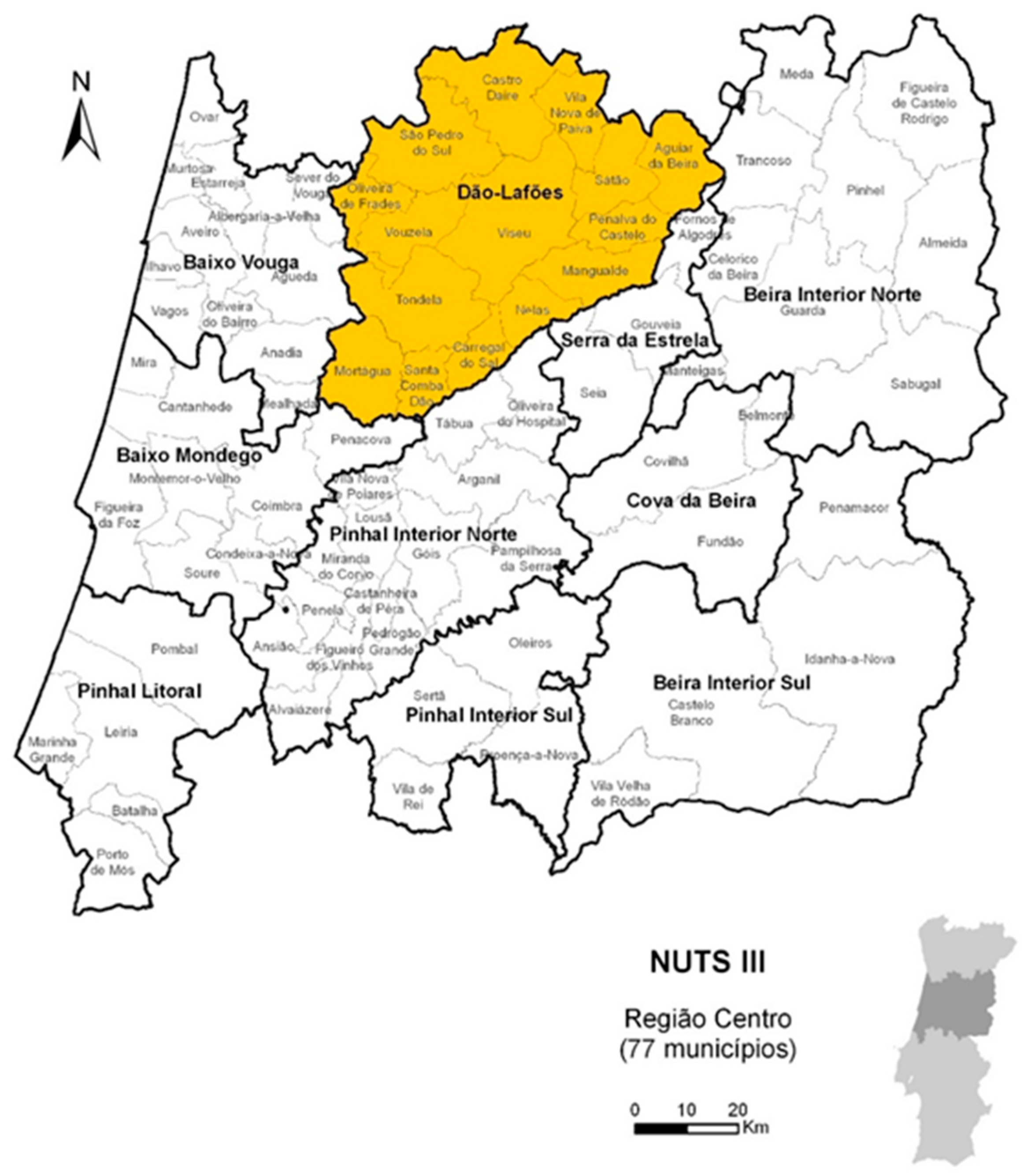
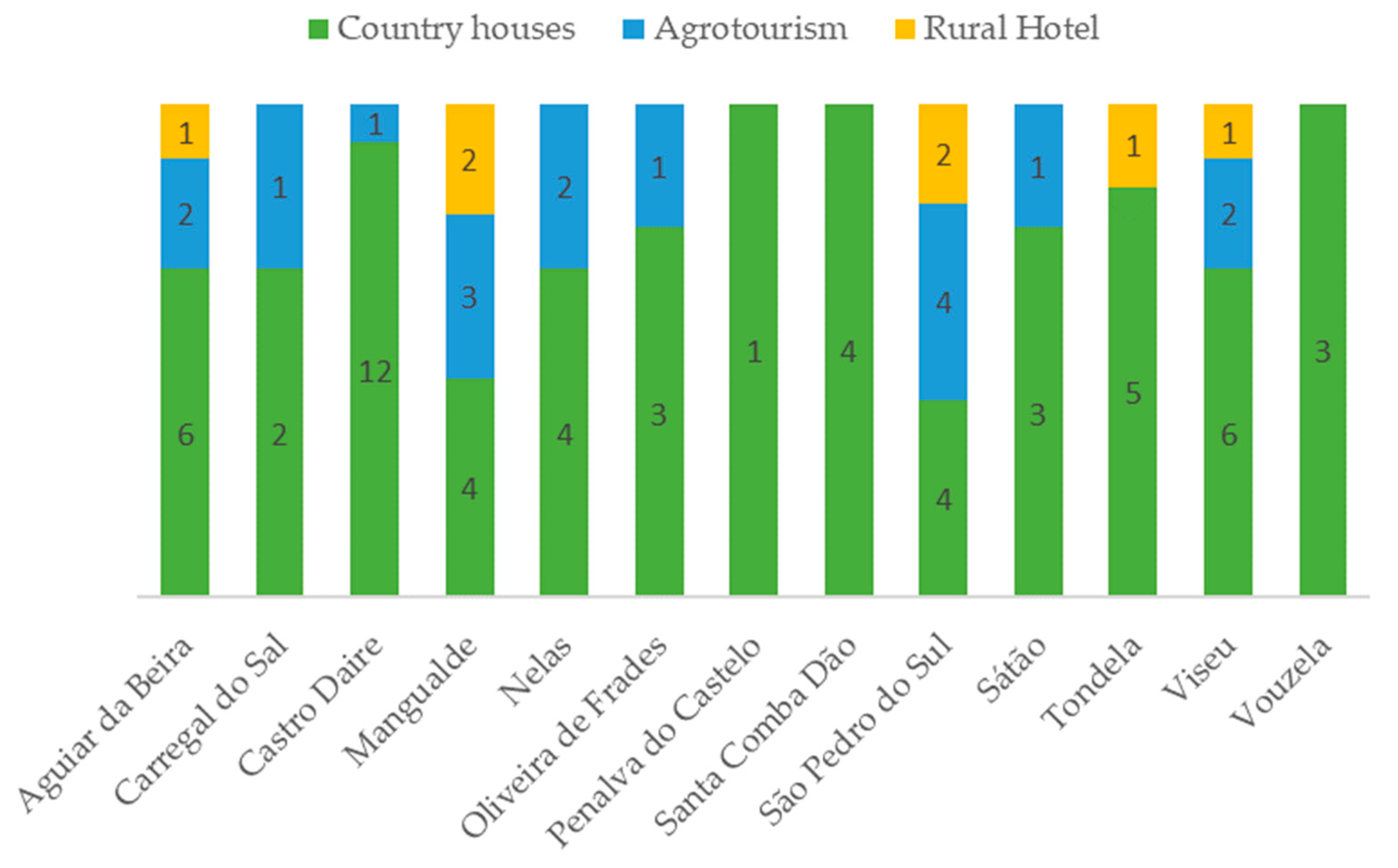
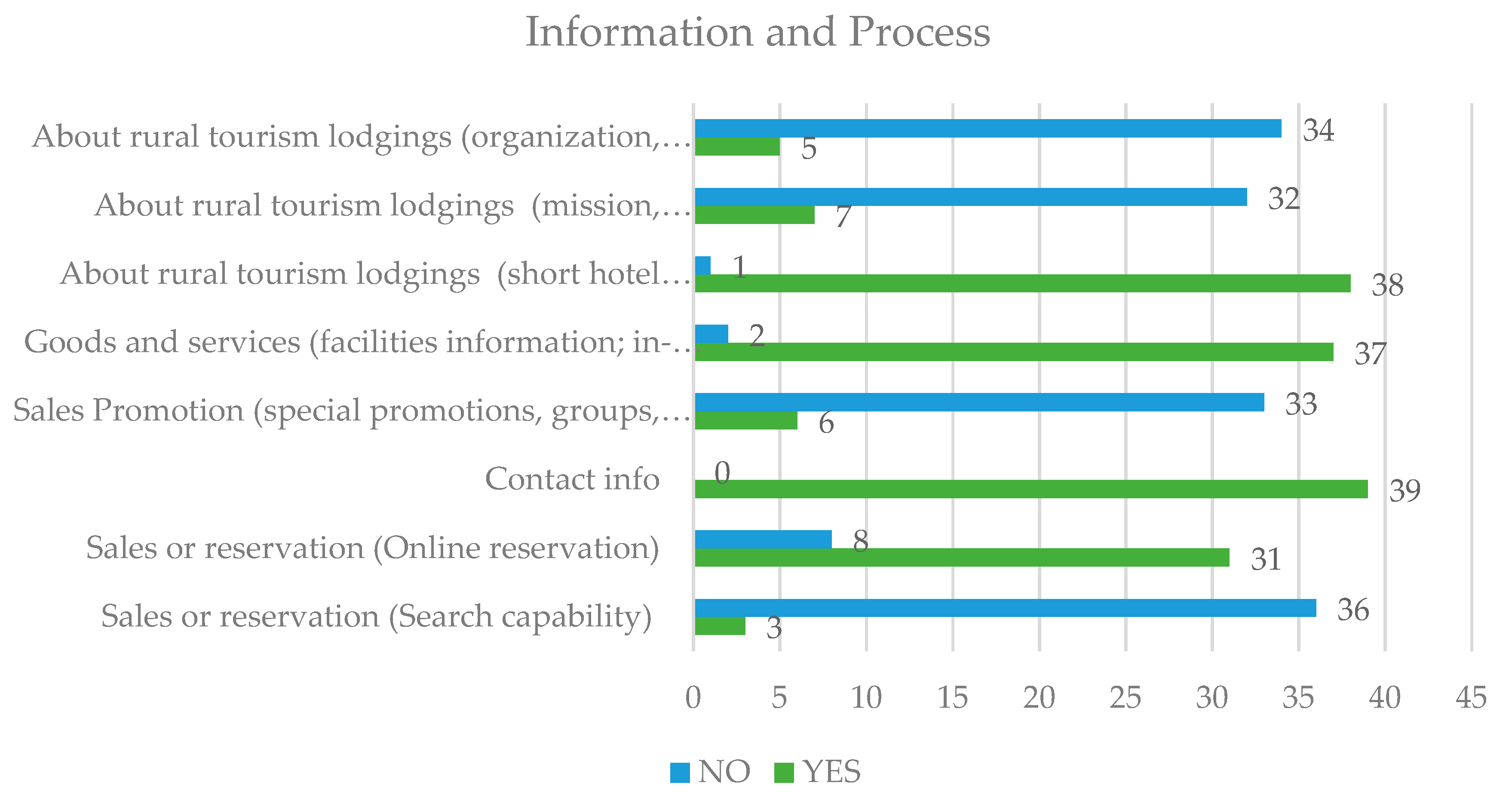
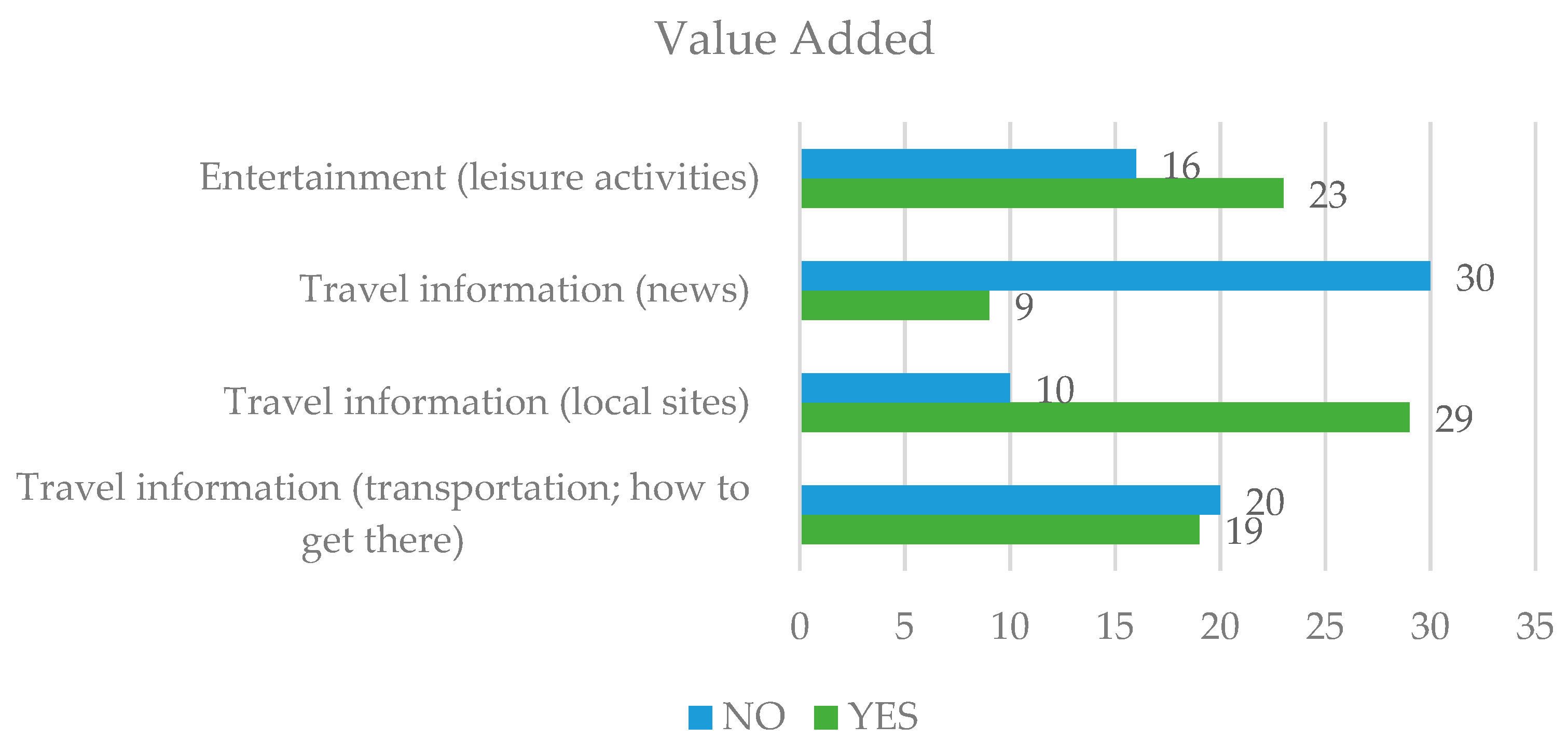

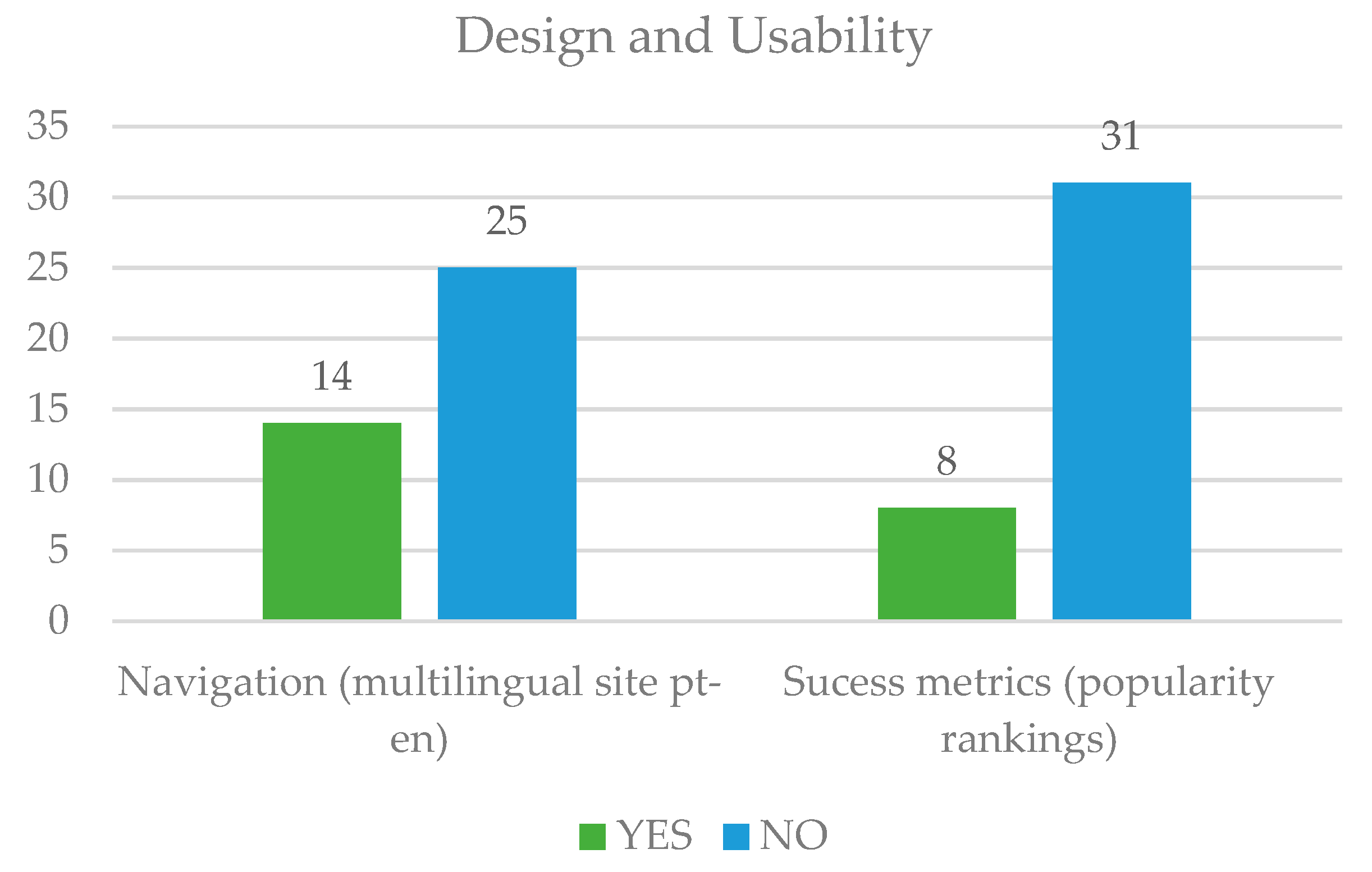

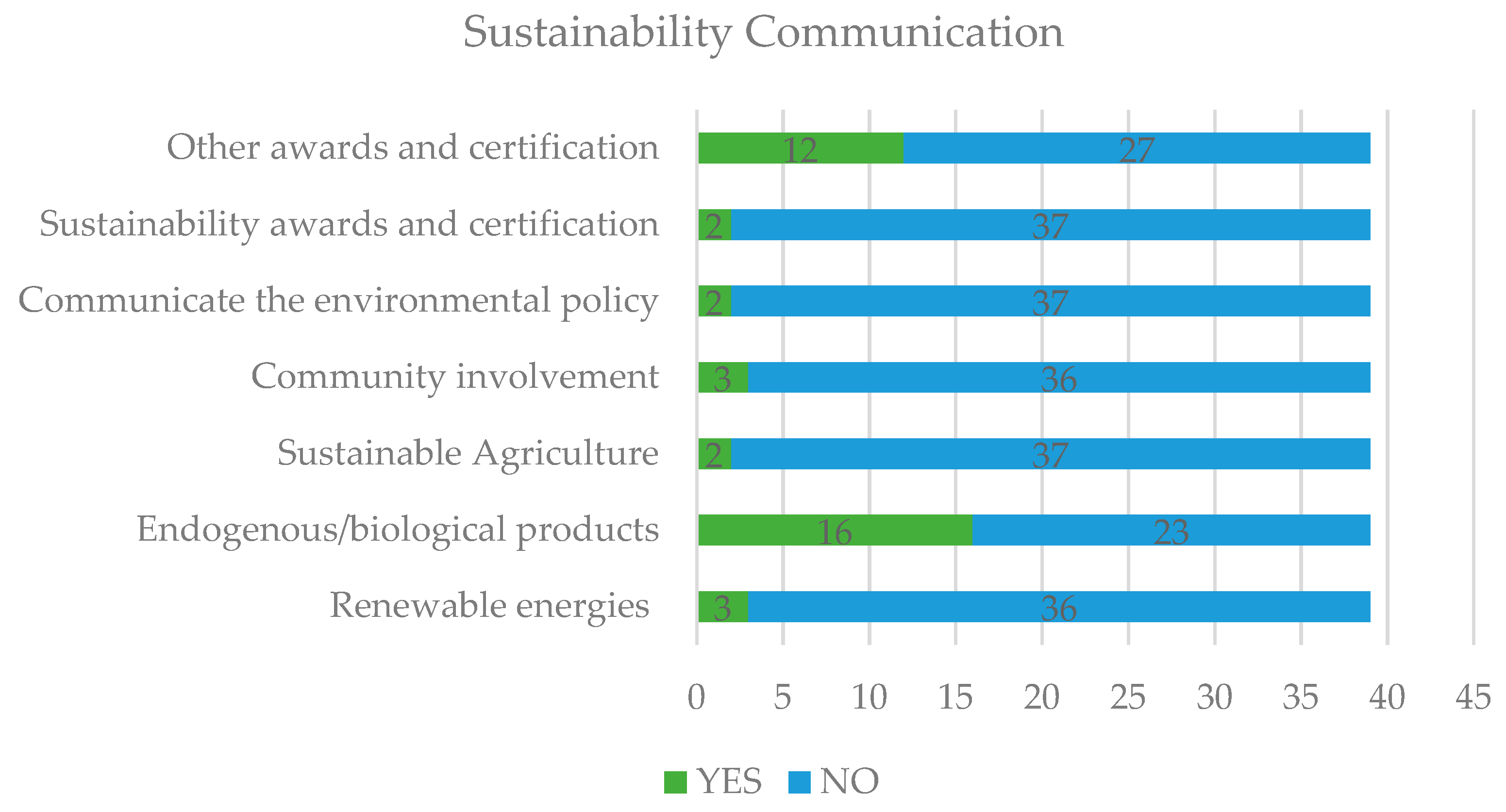
| Information and Process | Source |
|---|---|
| Sales or reservation: | Hashim, Murphy, and Law (2007) |
| -Search capability; | |
| -Online reservation | |
| Contact info | |
| Sales promotions: | |
| -Special promotions, groups; family/kids; honeymooners; | |
| Goods and services: | |
| -Room classifications; in-room photo | |
| About the rural tourism lodgings: | |
| -Short description; | |
| -Mission/purpose/values; | |
| -Organization/people | |
| Value Added | |
| Travel information: | Hashim, Murphy, and Law (2007) |
| -Transportation | |
| -Local sites | |
| -News | |
| Entertainment: | |
| -Leisure activities | |
| Relationships | |
| Loyalty/CRM: | Hashim, Murphy, and Law (2007) |
| -Guestbook | |
| -Newsletter subscription | |
| -Cookies | |
| Personal interest: | |
| -Comments/feedback | |
| -Online chat | |
| Design and Usability | |
| Navigation: multilingual site | Hashim, Murphy, and Law (2007) |
| Success metrics: popularity ranking | |
| Trust | |
| Copyright and security: privacy statement; copyright | Hashim, Murphy, and Law (2007) |
| Timeliness: date of last update (6 months) current and timely info | |
| Sustainability Communication | |
| Renewable energies Endogenous/biological products Sustainable agriculture Community involvement: employ local people, projects that help the community, activities and open spaces for the local community Communicate the environmental policy: sustainability report Sustainability awards and certification: eco-labels, etc. Other awards and certifications | Hsieh (2012); Olya, Altinay, Farmaki, Kenebayeva, and Gursoy (2020); Tiago, Gil, Stemberger, and Borges-Tiago (2021) |
Publisher’s Note: MDPI stays neutral with regard to jurisdictional claims in published maps and institutional affiliations. |
© 2021 by the authors. Licensee MDPI, Basel, Switzerland. This article is an open access article distributed under the terms and conditions of the Creative Commons Attribution (CC BY) license (https://creativecommons.org/licenses/by/4.0/).
Share and Cite
Pato, M.L.; Duque, A.S. Sustainability Communication in Rural Tourism: Website Content Analysis, in Viseu Dão Lafões Region (Portugal). Sustainability 2021, 13, 8849. https://doi.org/10.3390/su13168849
Pato ML, Duque AS. Sustainability Communication in Rural Tourism: Website Content Analysis, in Viseu Dão Lafões Region (Portugal). Sustainability. 2021; 13(16):8849. https://doi.org/10.3390/su13168849
Chicago/Turabian StylePato, Maria Lúcia, and Ana Sofia Duque. 2021. "Sustainability Communication in Rural Tourism: Website Content Analysis, in Viseu Dão Lafões Region (Portugal)" Sustainability 13, no. 16: 8849. https://doi.org/10.3390/su13168849
APA StylePato, M. L., & Duque, A. S. (2021). Sustainability Communication in Rural Tourism: Website Content Analysis, in Viseu Dão Lafões Region (Portugal). Sustainability, 13(16), 8849. https://doi.org/10.3390/su13168849







